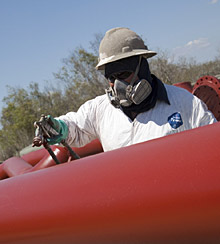Zero Injuries, Waste, and Harm
How AkzoNobel NV, a leading manufacturer, is making its health, safety, and environment procedures stronger by making them more consistent.
(originally published by Booz & Company)When my company, AkzoNobel, set out to standardize its approach to safety in 2008 after a large acquisition, it was at a disadvantage compared to many of its competitors. AkzoNobel, which manufactures paints, coatings, and specialty chemicals, is a large organization with about 50,000 employees. We’re certainly not alone among chemical companies in having far-flung manufacturing assets. But the 200-plus plants we had were unusually fragmented: Many of them had come to us via acquisition, often one or two at a time. When you add assets in this manner, it’s pretty common to end up in the situation we were in—for example, a Brazilian plant that made emulsion paint might have one set of safety policies, a Chinese plant making epoxies might have a second, and a Swedish plant making calcium chloride might have a third. All three safety approaches could be effective, but the fact that they weren’t standardized made it hard for AkzoNobel, which is headquartered in Amsterdam, to gauge results or make systematic improvements. The fact that we had these three distinct lines of business was another complicating factor.
It isn’t easy to ask several hundred line managers who have grown accustomed to doing things their own way to adopt a uniform set of practices. In 2008, when we told the people in charge of our manufacturing plants that we would be moving to a common safety approach—and that this transition would involve annual safety self-assessments, comprehensive audits, and the publication of each plant’s safety “rating”—the response was predictable: The plant managers weren’t happy. In retrospect, there were probably a few things we could have done differently to sell the idea. Our approach had basically consisted of throwing people into the deep end and telling them to start swimming. But the important thing was getting the company organized around a more coherent approach. That’s what we did, and we’re becoming a better company for it.
Safety—or health, safety, and environment (HSE), to use the more formal terminology—has become an increasingly visible part of the corporate agenda over the past 20 years. A lot of industrial companies that have historically been at risk of workplace incidents or environmental damage now set public goals of zero injuries and no environmental harm. We aspire to these goals, too (and to a third goal, no waste). But we think we’re different because of the systematic ways we’re pursuing these objectives. When we began the process, our high degree of fragmentation made the problem seem especially challenging. But paradoxically, we think such a difficult starting point will propel us to a position of industry-leading safety over time, and help us achieve better financial performance along the way. Our diversity can also be a strength.
Why did AkzoNobel’s plant managers initially have such a visceral reaction to the changes we were making? To start with, it was one hell of a lot of work.
Why such a visceral reaction to the change? To start with, it was a hell of a lot of work.
The self-assessment documents that are at the heart of our HSE improvement efforts have 400 questions and take, on average, more than three days to complete. The categories include leadership involvement in risk management, security of people and assets, and site environmental impact. The section on emergency response and crisis management, for instance, has 19 statements, including “Emergencies and crises are handled as each occurrence requires” and “Emergency procedures are exercised with local authorities via joint drills regularly.” The answers (yes, no, or not applicable) become part of an overall safety maturity score for the plant that ranges from 0 to 10. The answers also help identify any safety gaps at the plant and inform an improvement plan. As of late 2013, the average plant at AkzoNobel had a safety maturity score of 6.4. Our goal, which has the enthusiastic backing of our CEO, Ton Büchner, is to get every plant above a score of 8 and to be in the top quartile within our industry by 2015.
The Need for a Methodical Approach
HSE isn’t rocket science. In fact, I would argue it’s a commodity. Although factories have different hazard profiles, how you run safety in Factory A is almost identical to how you run safety in Factory B, C, or D, regardless of what the factories are making. HSE involves the culture, the line management, the training, the systems, and the procedures. Our objective, in addition to creating transparency about safety performance, is to create a common platform for behavior-based safety, product safety, and process safety management so that we can keep the needle moving in the right direction. (For more on these concepts, see the sidebar below, “The Rudiments of HSE.”)
One of my jobs is to train plant managers in our common safety platform, and a few years ago I had a new manager in Indonesia in one of my courses. He came up to me during a break and said, “Look, I understand what we’re trying to do and I think it’s great. But I just took over this plant and I’m told my plant is up for an immediate safety audit. I think I should ask the audit team to come back in a year, after I’ve got more of a system in place. Can you intervene on my behalf?” I told him the auditors would probably not accept a delay, which in fact they did not.
A few weeks later, the manager’s plant received a score of 2.3 out of 10, and he was embarrassed. “Look,” I said to him, “embrace it. You just arrived on this site. You have the benefit now of knowing exactly where you’re starting from. And when—after three or four years—you’ve turned this site around and instead of a score of 2.3 you’ve got a score of 6.3, you’re going to be a knight in shining armor.”
Indeed, the thing that’s evolved most over the course of our HSE push is our plant managers’ attitudes toward it. They love it now; they embrace it. Why wouldn’t they? If you’re a plant manager, you care about your people, your reputation, and how effective your production assets are. If you have a factory that’s not safe, your assets aren’t going to be effective. If your people are getting injured or hurt, you’ll have a motivation problem. And if you’re leaking product into the environment, you’ll get a bad reputation. All those things will damage your career and keep you up at night.
It’s also worth noting that most factory managers are engineers. If you give engineers a system and structure to work with, a template, they’re usually happy and they don’t want to change it. Our common safety platform appeals to them for those reasons.
You’ll notice I’m saying quite a bit more about line managers’ roles in our HSE improvement efforts than about the role of the HSE staff itself. That’s deliberate—and it’s no knock on our HSE function. We’ve got a great HSE staff. They carry out our audits, serve as coaches on safety issues, and help us comply with the regulations of the many different countries in which we operate. Our HSE staff members are also involved in an ongoing effort to help us identify and reduce our use of particularly hazardous substances. For instance, we were one of the first paint companies to completely stop using lead as an ingredient. But we don’t rely on HSE staff for day-to-day site safety issues. That responsibility falls to a handful of managers at each manufacturing site—including the site manager, the production manager, and the maintenance manager. If you’re in one of these leadership positions, we empower you. And by that, I mean we give you the authority to follow a zero-tolerance policy if people don’t want to obey basic lifesaving rules. You have not only the power to fire workers in those situations, but a duty to do so.
By making safety a responsibility of our line managers and embedding it in our culture, we’re taking a different approach. I have seen how other companies handle safety, and few of them embed it in their operations and make it the responsibility of their line managers, the way we aim to do. Of our roughly 50,000 employees, between 1,000 and 2,000 are plant managers who receive formal training in best practices related to safety.
Safety as a Foundation of Corporate Success
Embedded safety and sustainability, as we call it, is one of AkzoNobel’s five strategic focus areas. (The other four are care for the customer, reduction of product and process complexity, cash and return on investment, and diverse and inclusive talent development.) We believe we have to excel and do a better job than other companies do in all these areas. They are the key areas that our board of directors and CEO pay attention to, and are the foundational elements of our success. In the case of embedded safety and sustainability, the logic—the connection between achieving our goals and being financially successful—is pretty simple. If you have a safe plant, it will be well maintained and reliable, and people will like working there. That isn’t the only thing you need in order to have a plant that’s competitive and profitable, but it’s probably the most important starting point.
Our journey toward improving our safety performance has had some ancillary benefits. For instance, we’ve now got a mechanism for training new plant managers. Most manufacturers promote people on the basis of their talent and past performance—and don’t often bother to communicate expectations or train these high-achieving individuals. At our company, new plant managers get formal training in the common safety platform.
In addition, our development of a transformation process for safety—one that will take us from a high level of cross-site variability to a high level of cross-site consistency—may serve as a model for other change efforts. We could apply a similar change model to human resources, finance, or procurement, three other areas where our processes differ widely.
Still on the Journey
Where are we now? Our safety maturity scores are going up, and because they’re a leading indicator, we are confident that our injury rate (a lagging indicator) will go down. Already we’ve seen higher engagement scores at locations with high safety maturity ratings—those scores show how committed employees are to the company’s success and how satisfied they are with their jobs. We can’t be sure which is the chicken and which is the egg when it comes to safety maturity and engagement. But we know there’s a correlation.
Safety, in the end, is akin to a pyramid where the basic level of development is at the bottom and organizations rise through different levels. At the base are situations where safety is imposed from the outside—through a central department or even through a government overseer. At a higher level, safety becomes an individual responsibility. And then, in the most evolved stage, safety becomes a group responsibility, with everyone looking out for everyone else.
It’s far too early in our journey to claim superlative achievements, but it would be hard to be more ambitious about HSE goals than we are. It’s our intention to be the best company in the world in HSE, and we feel as if we’re on the road to achieving that goal.![]()
The Rudiments of HSE
AkzoNobel’s push to eliminate all worker injuries and become a leader in safety and environmental performance relies on five central elements:
-
Transparency. Each of AkzoNobel’s 240 manufacturing plants rates itself with a safety maturity score between 0 (the lowest possible level) and 10 (the highest); the scores are available to all plant managers within the company and to the CEO. The idea is that such transparency will help managers gauge their plant’s performance in relation to that of their peers and show specific areas where they need to learn from others.
-
Behavior-based safety. Specific behaviors that increase risk are listed at each work site. Workers exhibiting what peers deem “at-risk” behaviors receive prompt, no-blame feedback on what they must do differently.
-
Process safety management (PSM). This is a systematic framework for managing the risks associated with a plant’s operations and processes, as well as any hazardous substances the plant produces. Among other things, PSM covers the development of catastrophe scenarios (and responses), the identification of critical equipment, the investigation of incidents, and the establishment of a training matrix for safety-related competencies.
-
Management of priority substances. AkzoNobel has started a comprehensive program to help identify and phase out the use of substances that pose a risk to human health or the environment. The company’s goal is to be constantly evaluating the safety characteristics of the substances it uses, instead of doing so only in response to regulatory pressure.
- Embedding of safety practices in the company’s culture. At most companies, HSE is the responsibility of a central function. AkzoNobel is following a different paradigm, training the top managers at all its plants in safety leadership in the belief that this approach will turn the company as a whole into a safety leader.
Author profile:
- Richard Westlake is director of health, safety, and environmental (HSE) policy and capability building at AkzoNobel NV.







